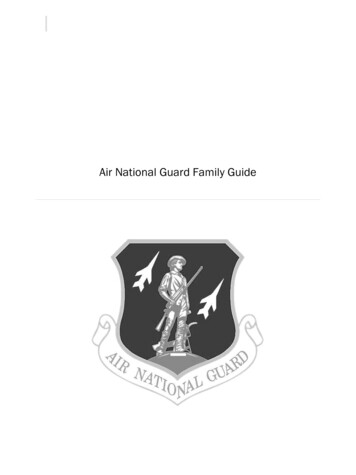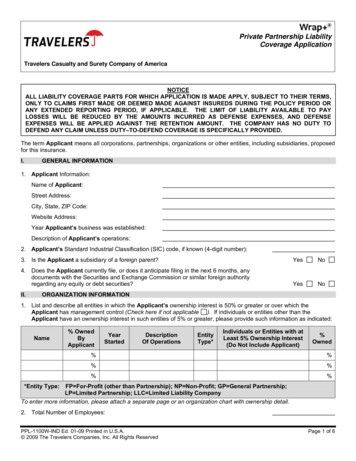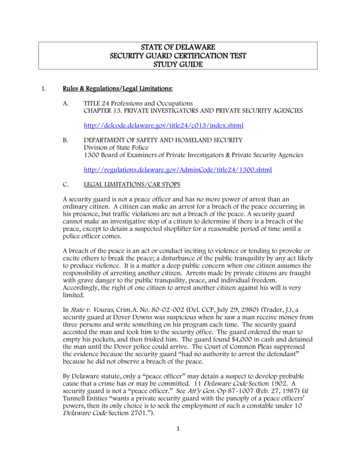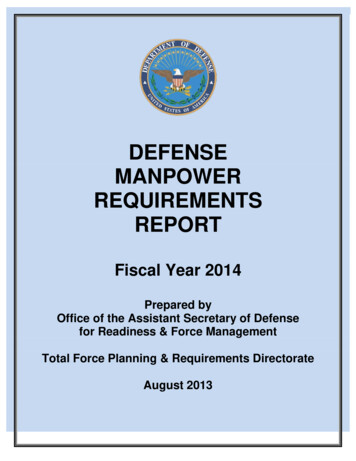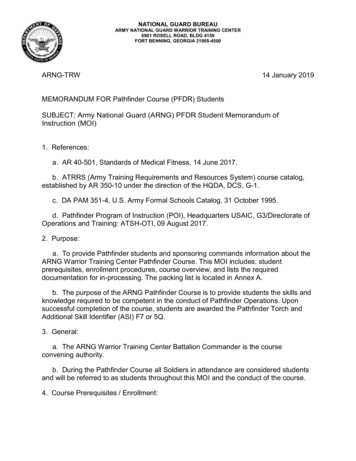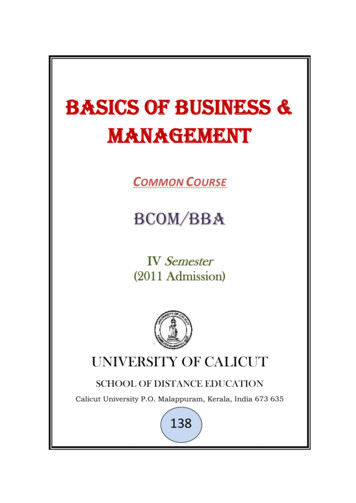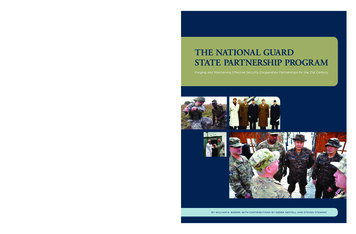
Transcription
THE NATIONAL GUARDSTATE PARTNERSHIP PROGRAMForging and Maintaining Effective Security Cooperation Partnerships for the 21st CenturyPUBLISHED BY HISTORICAL SERVICES BRANCH, PUBLIC AFFAIRS OFFICE, NATIONAL GUARD BUREAU, ARLINGTON VA, 2014BY WILLIAM B. BOEHM, WITH CONTRIBUTIONS BY DEREK NESTELL AND STEVEN STEARNS
THE NATIONAL GUARDSTATE PARTNERSHIP PROGRAMForging and Maintaining Effective Security CooperationPartnerships for the 21st CenturyB Y WI L L I A M B . B O E H M , WI T H CO NTRI BUTI O NS B YD E R E K N E ST E L L A N D ST EV E N STE ARNSNATI O NA L GUARD BURE AUO F F I CE O F P UB L I C A F FA I RSHI STO RI CA L SE RVI CE S B RANCHARL I NGTO N, VI RGI NI A 22204Layout and design by LM&O Advertising
C A P T I O N S , C LO C KW I S E F R O M U P P E R L E F T P H OTO, F R O N T COV E R :Sgt. 1st Class Tony Duben, of Devils Lake, N.D., works with Staff Sgt. Quave, a soldier in the Ghana Army, to prepareexplosives for detonation in February 2011. Duben and Sgt. 1st Class Paul Deegan, both instructors with the North DakotaNational Guard’s 164th Regional Training Institute, traveled to Ghana as part of a combat engineer instructor exchange.Two Ghanaian instructors have spent the past two weeks in North Dakota as part of the latter half of the exchange.Photo by Sgt. 1st Class Paul Deegan, North Dakota National Guard.Army Gen. Frank J. Grass, chief of the National Guard Bureau, talks with Mongolian soldiers serving in Afghanistan,Jan. 15, 2013. Mongolia is partnered with Alaska in the National Guard State Partnership Program. U.S. Army photo bySgt. 1st Class Jim Greenhill.Lt. Gen. (USAF) John B. Conaway (fourth from left), is greeted upon his arrival in Riga, Latvia by unidentified membersof the Latvian Defense Force (in brown coats), along with other local officials on Nov. 16, 1992. Accompanying Lt. Gen.Conaway is Brig. Gen. (USAF) Thomas Lennon, on the extreme right. This trip to the Baltic states (Latvia, Lithuania, andEstonia), the first by officials of a Western state in over 50 years, marked the accession of the National Guard StatePartnership Program. Photo courtesy of retired Col. Max Alston.New Jersey Army National Guard soldier and an unidentified Albanian physician clasp hands in a gesture of friendship,July 2007. This took place during a Unit Level Exchange, part of the ongoing bilateral relationship that the New JerseyNational Guard maintains with the Republic of Albania. This is part of the State Partnership Program, sponsored by theNational Guard Bureau and European Command. Photograph by Capt. (USAF) Jon Powers, New Jersey National Guard.C A P T I O N S , C LO C KW I S E F R O M TO P P H OTO, B AC K COV E R :Spc. Eric D. Mackey and his Serbian army civilian counterpart Milosevic Miroslay share stories of the day’s work atSvetozar Markovic elementary school in Lapovo, Serbia, where they are completing renovations together through theNational Guard Bureau State Partnership Program. Ohio and Serbia have been partnered since 2006. Department ofDefense photo by 1st Lt. Nicole Ashcroft.A Vermont National Guardsman observes a Macedonian military policeman during the rifle marksmanship training portionof Operation Rising Phalanx, which took place in Krivolak, Macedonia Sept. 9-22, 2006. The U.S. European CommandState Partnership Program sponsored field exercise culminated a 10-month small unit exchange to train MacedonianArmy military police platoons to take part in international peacekeeping missions. The State Partnership Program, whichoriginated in 1993, links a National Guard state with a partner nation in support of USEUCOM’s Theater Security Cooperation objectives. Department of Defense photo.Maj. Gen. Deborah A. Ashenhurst (right), Ohio National Guard Adjutant General, talks with newly appointed femaleSerbian officers. Photo by Staff Sgt. Peter Kresge.Boehm, William B., author.The National Guard State Partnership Program Forging and Maintaining Effective Security Cooperation Partnerships forthe 21st Century / by William B. Boehm, with Derek Nestell and Steven Stearnspages cmIncludes bibliographical references.ISBN XXX-X-XXXXXX-XX-X1. State Partnership Program. I. Title.XXXXXXXXXXXXXXXXXXTo obtain copies of this document, please contact the Superintendent of Documents, U.S. Government Printing Office,Internet: bookstore.gpo.gov / Phone / Fax / MailiiTHE NATIONAL GUARD STATE PARTNERSHIP PROGRAM
THE NATIONAL GUARDSTATE PARTNERSHIP PROGRAMForging and Maintaining Effective Security CooperationPartnerships for the 21st CenturyB Y W I LL I A M B . B O E H M , W I T H CONTRI BUTI O NS B YD E R E K N E ST E L L A N D ST EV E N STE A RNSPublished by Historical Services BranchOffice of Public AffairsNational Guard BureauArlington VA, 2014NATI O NA L GUARD BURE AUO F F I CE O F P UB L I C A F FA I RSHI STO RI CA L SE RVI CE S B RANCHARL I NGTO N, VI RGI NI A 22204
ivTHE NATIONAL GUARD STATE PARTNERSHIP PROGRAM
TABLE OF CONTENTST HE N AT I O N A L GUA R D STAT E PA RTNE RSHI P P RO GRA M:F ORG I N G A N D M A I N TA I N I N G E FFECTI VE SE CURI T Y CO O PE RATI O NPA RT N E R SH I P S FO R T H E 21ST CE N TURYFOREWORDPREFACEACKNOWLEDGEMENTSCHAPTER ONE:viviiviii1Beginnings of the State Partnership ProgramCHAPTER TWO:11Establishing the SPP in Europe and Central AsiaCHAPTER THREE:26Expanding the SPP from Europe to the Western HemisphereCHAPTER FOUR36Establishing the SPP in Asia and AfricaCHAPTER FIVE:45Partnerships at Work: Providing International SecuritySolutions in Support of Defense StrategyCHAPTER SIX:52The SPP: Department of Defense Program of RecordCHAPTER SEVEN:58The SPP: Security Cooperation Model for the 21st CenturyAPPENDICES66SPP MILESTONES77ACRONYMS79BIOGRAPHIES80TABLE OF CONTENTSv
FOREWORDaintaining alliances and developing partnerships haveMThese SPP relationships are true partnerships. Based on reciprocity,long been fundamental elements of U.S. securitymutual benefit and mutual respect, the SPP stands out as an innovative,strategy. Ensuring a stable international system islow-cost, small-footprint/high-impact program that can help keepbeyond the capacity of a single nation. It requiresour alliances fit, strengthen existing partnerships, and develop newthe collective efforts of like-minded countries willing to shoulderones. DOD Strategic Guidance and the Defense Budget Priorities andresponsibilities for promoting global peace and security. The UnitedChoices Fiscal Year 2014 both note the importance of building partner-States depends on robust foreign relationships to help protect itsship capacity with friends and allies for sharing the costs and responsi-national security and advance a peaceful world.bilities of global leadership. The National Guard is grateful that SPP isIn this context, I am pleased to introduce this monograph on thehistory of the National Guard State Partnership Program (SPP).identified in both documents as one of the key partnership developmentefforts that are worthy of increased DOD investment.Titled The National Guard State Partnership Program: Forging andThe purpose of this monograph is to convey that strong, mutuallyMaintaining Effective Security Cooperation Partnerships for the 21stbeneficial relationships are crucial to maintain the capacity of the UnitedCentury, it provides a comprehensive overview of SPP’s achievements overStates and our friends and allies to work together to meet commonthe past 20 years and highlights its promise for the future.security challenges. As we seek to create a more robust culture of defenseLaunched in 1992 as part of the United States Department of Defense(DOD) and United States European Command initiatives to engagecooperation in an era of evolving security challenges and limited defenseresources, I trust the success of the SPP can serve as a valuable reference.with the defense ministries and armed forces of the newly independentnations of the Baltics, Central and Eastern Europe and Eurasia, the SPPhas 68 partnerships with 74 nations around the globe as of 2014. Theconcept of partnering a National Guard state organization with a foreigncountry’s defense ministry and armed forces, or the equivalent, for skillsexchanges, military exercises, planning drills, information sharing, crisismanagement collaboration, defense reform, military modernizationprojects, and professional development has proven to be an excellentmeans of security cooperation in direct support of the GeographicCombatant Commanders.The long-term, enduring relationships forged between National Guardsoldiers and airmen and their SPP partner nation defense and militarycounterparts have enabled us to work closely together on shared missionsin Iraq, Afghanistan, Libya, the Balkans and the Sinai in Egypt. TwelveSPP partner nations have become NATO members and five more areaspirants for membership. Two of the five U.S. treaty allies in the Pacificare SPP partners and all of the 22 SPP partner countries in the WesternHemisphere have shared security responsibilities as members of theOrganization of American States.viTHE NATIONAL GUARD STATE PARTNERSHIP PROGRAMFrank J. GrassGeneral, USAChief, National Guard Bureau
PREFACEThis monograph commemorates the 20th anniversary ofPolicy requirements change to meet complex security challenges, and thethe National Guard’s State Partnership Program (SPP) inSPP has demonstrated over the years its flexibility in supporting evolving2013. It provides a narrative history of the program fromnational security and foreign policy objectives.its inception following momentous changes in Centraland Eastern Europe and Eurasia in the early years of the last decadeof the 20th century; continues through the early development of theprogram, its expansion to six Geographic Combatant Commands; andconcludes with observations on the significance of the program todayand for the future as it builds enduring and strategic security relationships with countries across the globe.The SPP has evolved from a small program that was virtually unknownoutside the National Guard to a program strongly supported by all theCombatant Commands and widely acknowledged by our nation’s executive and legislative leadership. The reader is encouraged to keep in mindthat the program has developed steadily over its 20-year history to meetnational security objectives identified in higher-level policy guidance.The SPP originated when legislation, policy and the very construct ofsecurity cooperation existed in a formative stage. In those days, Combatant Commanders were known as CINCs, or, Commanders-in-Chiefof their respective commands. Office personnel had recently ended theuse of typewriters and embraced the newest computers. The Secretaryof Defense’s (SecDef ) Security Cooperation Guidance was two pageslong. The Guidance for Employment of the Force (GEF), QuadrennialDefense Review (QDR), and other strategic-level guidance did not exist.The year 2005 marked a significant turning point as seminal guidancewas issued through new products and direction. Those who managesecurity cooperation programs today have a combined set of directivesand guidance, including National Security Policy Directive (NSPD)44, establishing Stability Operations; Department of Defense (DOD)
ACKNOWLEDGEMENTSof Staff task force on security cooperation reform; and the maturationTof the GEF, Joint Strategic Capabilities Plan, the Joint Capability Areas,people in its 20 years of existence, and the writing of this monograph hasand the Joint Universal Task List.similarly depended on extensive cooperation among the staff in the PublicDirective 3000.05, establishing Stability Operations as a core function of DOD akin to offensive and defensive operations; Secretary ofDefense’s memo to the National Security Council regarding securitycooperation organizational challenges; the Chairman of the Joint ChiefsThis 20-year maturation is manifest within the SPP, as the “program”he research, writing and editing of this work would nothave been possible had it not been for the assistance ofmany talented individuals representing a broad spectrumof interests. The success and continued growth of the StatePartnership Program (SPP) has depended upon the cooperation of manyAffairs Directorate of the National Guard Bureau and elsewhere.sits between the executive and legislative branches with respect toFirst, allow me to thank Gen. Frank J. Grass, Chief, National Guarddoctrine and mission versus legislation. The SPP bridges the organiza-Bureau (CNGB), who supported the publication of this work. I also wishtional constructs of State and Defense, with varying levels of ownershipto convey my sincere appreciation to the former Chief, General Craig R.between Air Force, Army and Joint, and the vertical application of statesMcKinley. He initially commissioned this book in 2011.versus federal interests with respect to internal security and engagement.The states have a vested interest and are key contributors as well assub-national actors.Two staff members of Historical Services, Steven Stearns and DerekNestell, contributed to the research and writing of the manuscript.They also conducted several oral history interviews with state AdjutantThe monograph trajectory is as follows: Chapter 1 describes the emer-Generals, SPP coordinators, Joint Force Headquarters staffs, and othergence of the SPP from a concept developed by Chief, National Guardprogram officials.Bureau Lt. Gen. John Conaway into functional and robust securitycooperation relationships with newly independent countries in EasternEurope in the early 1990s. Chapter 2 discusses the expansion of the SPPinto most of Eastern Europe and Central Asia. Chapter 3 shifts focusto the Western Hemisphere to explain the expansion of the SPP as aprogram built upon previous ad hoc security cooperation relationshipsin the region from the 1980s and earlier. Chapter 4 describes the growthof the SPP in Asia and Africa and how mutually beneficial activities inthose regions have addressed security challenges. Chapter 5 providesexamples of how SPP relationships with partner countries have beenMany thanks to LTC Jeffrey Larrabee, Chief, Historical Services Branch,for continuing to encourage our team to fine-tune this work for it tobecome a valuable resource for the SPP. Mr. Al Miller, former Chief,Historical Services assisted with editing. Our other colleague, USA Maj.Tom Mehl, provided assistance and encouragement along the way. USALt. Col. Les’ Melnyk, Chief, Strategic Communication and our formercolleague from the History Branch also contributed editorial assistanceto my first draft. He provided excellent counsel in the process of writingmany of the sections of the manuscript.leveraged to provide practical and functional dividends in the form ofMany thanks go to the Public Affairs Directorate staff, most notably theco-deployments, co-security training, and other burden-sharing in Iraq,Command Information staff. They helped locate photographs for theAfghanistan and elsewhere. Chapter 6 examines the rise of the SPP to thebook, assisted Historical Services with video interviews, and facilitatedstatus of Program of Record within the DOD; how SPP has navigatedour requests to state Public Affairs Offices for additional images thatnew responsibilities in planning, reporting and oversight; and how theaugment the great work being done in the states and overseas. BranchNational Guard Bureau is taking a new look at the policy and authorities affecting the scope and execution of SPP activities and adaptingthe program accordingly. Chapter 7 underscores the significance of theprogram today and looks at the future of the SPP as it builds upon existing relationships, considers new ones, and proactively addresses complexchallenges in the 21st century in a resource-constrained environment.viiiTHE NATIONAL GUARD STATE PARTNERSHIP PROGRAM
Chief USAF Maj. Randy Saldivar, USA Sgts. 1st Class Michael Houk,suggestions based on their extensive knowledge of the program wereand Jim Greenhill and Master Sgt. Paul Mouilleseaux, and Staff Sgt.very helpful. Mike Braun provided special expertise that helped frameMichael Dann all lent valuable assistance.the SPP in terms of security cooperation doctrinal changes over theSpecial thanks also go out to the many respondents who consented tobe interviewed for this monograph. First among them was retired Lt.Gen. John Conaway, who, along with retired Cols. Vance Renfroe, MaxAlston, and Wayne Gosnell, agreed to a comprehensive interview aboutthe beginnings of the SPP. They are true gentlemen in every sense of theword. The many state officials, including state adjutants general, whoyears. Mike Lashinsky provided a fresh perspective and critical eye thatwere very helpful in this collaborative effort. Jon’s editorial advice addedgreatly to the work. His insight and expertise, particularly with regardto funding and the future strategy of the SPP, were indispensable. Hiambrought a needed international viewpoint to this publication, and hereditorial comments helped the readability of the document a great deal.participated in oral history interviews, also provided valuable insightOne final resounding “thank you” goes to Dr. John Finney, formerinto the program. Partner country personnel participated in this projectForeign Policy Advisor (POLAD) to the Chief, National Guard Bureau,as well, which provided additional perspective. We were fortunate toand currently Special Advisor for International Security Cooperation.interview Her Excellency, the president of the Republic of Kosovo,Dr. Finney’s far-reaching knowledge of international affairs made meAtifete Jahjaga, whose interview will be incorporated into an associatedhighly aware of the complexity of this project. He encouraged me tovideo on the SPP.examine the initial framework of the SPP with regard to NATO and theI want to thank Mr. John Malthaner, NGB Public Affairs, particularlyfor his comprehensive editing of the bulk of my manuscript. John isa consummate professional and a great wordsmith, and his excellentediting skills enhanced the readability of this work. Thanks also to USACol. Eric Maxon, Chief of NGB Public Affairs, for his faith and supportthroughout this project.USA Col. Tracy Settle, director of International Engagement for theNational Guard Bureau’s International Affairs Division, graciouslyagreed to be consulted for this project. Col. Settle’s knowledge of theSPP at the NGB is detailed and comprehensive, and we were fortunate to receive his insights on the program. The International AffairsDivision staff was especially helpful in reviewing this monograph andproviding recommendations.Central and Eastern European republics. He reminded me to includethe importance of the Geographic Combatant Commands and providednecessary structure through his counsel. Above all, Dr. Finney encouraged the Historical Services Branch to resume its work with this projectwhen it once appeared to be dormant. His faith and support in my ability to complete this work has been greatly appreciated.To all other individuals associated with the SPP and all those workingin support of it, please accept my unwavering gratitude for yourgenerosity and assistance in completing this project.Thank you all very much.William B. BoehmArlington, Va.March 31, 2014I also would like to thank Mr. Mark Bour, Mr. Mike Braun, Mr. JayGates, Mr. Mike Lashinsky, Mr. Jon McIntosh, and Ms. Hiam Nawasfor their editorial advice and review of my chapters. Mark’s and Jay’sACKNOWLEDGEMENTSix
CHAPTER 1B E GI NNI NGS O F THE STATE PA RTNE RSHIP PROG R AM
The weather was cold and rainy the morning of Sunday,November 15, 1992, as a Boeing 727 jet awaited 38passengers and 10 air crew members on the tarmac ofAndrews Air Force Base in Maryland. The 7 a.m. flightwould take this group to the Baltic Republic of Latvia. The plan wasto spend two days in the capital city of Riga, then continue on to theneighboring countries of Estonia and Lithuania. The pending departurecreated an air of anticipation, as the group was headed to destinationsthat had been closed to the Western world for more than four decades.The 38 passengers were a joint interagency group representing theNational Guard Bureau (NGB), United States European Command(USEUCOM), the Office of the Secretary of Defense (OSD), theJoint Chiefs of Staff (JCS), U.S. Department of State (DOS), defenseattachés from all three Baltic republics, and a team of civilian physicians and National Guard emergency planners. They were embarkingon the first steps of a program that would become a key component ofthe Department of Defense (DOD) security cooperation strategy in theyears following the Cold War and the collapse of the Soviet Union. Newcountries were emerging from the swift changes taking place in the early1990s, and the DOD sought to engage the defense and military establishments of these new nations and offer assistance with their modernization and transformation. This trip marked the beginning of enduringinternational engagement through a unique DOD security cooperationprogram that would spread worldwide over the next 20 years.1The National Guard State Partnership Program (SPP) arose out ofDOD efforts to assist the militaries of the former Soviet bloc nations ofCentral and Eastern Europe transition to democratic rule following thecollapse of the Soviet Union in 1991.CHANGING TIMES, SHIFTING RESOURCESAt this opportune time, the National Guard offered its expertise asthe United States’ oldest military force. It had been seeking ways tocontinue its valuable contributions to U.S. national security overseasfollowing the collapse of the Soviet Union. The Warsaw Pact was nolonger a threat. The challenge was in winning peace. The NGB saw anopportunity to leverage the skills and versatility of its citizen-soldiersand airmen at the grassroots level to build a lasting peace for America’sformer adversaries.In a letter dated January 2, 1992, Chief of the National Guard Bureau(CNGB), U.S. Air Force (USAF) Lt. Gen. John B. Conaway informedChairman of the JCS, U.S. Army (USA) Gen. Colin L. Powell thatthe National Guard stood ready to offer advice and provide personnelto any initiative that would allow the newly independent countries ofCentral and Eastern Europe an opportunity to consider a “NationalGuard structure.” 4 Conaway’s letter made Powell and the DODhierarchy aware of the National Guard’s willingness to supporttransition missions in Europe and serve as a template for institutionalreinvention. Conaway then instructed his staff to construct a frameworkfor assisting the former Soviet bloc countries. This document wouldfirst be shared with Vice Chief of the NGB (VCNGB), USA Maj. Gen.William Navas.Conaway’s executive staff included capable analysts that offered crucialadvice at this important juncture. Three principals involved in the earlystages of formulating what would eventually become the SPP wereUSAF Col. Vance Renfroe, Kentucky Air National Guard, Air NationalGuard (ANG) director of Operations and Programs; Col. WayneGosnell, Army National Guard (ARNG), chief of the NGB Office ofGiven the new international security environment following the fall ofInternational Initiatives, which later became the NGB Internationalthe Soviet state, a serious debate had begun in the United States and inAffairs Division (NGB-IA); and Max Alston, a retired USA Reservewithin the North Atlantic Treaty Organization (NATO) over whethercolonel working on Military Support to Civil Authority (MSCA) issuesthe alliance should expand eastward. Some argued that the alliance hadin the Office of the Under Secretary of Defense for Policy (OUSDP).served its purpose, including former DOS policy planning chief andThis trio brought strengths from a wide range of work experiences andleading Russian analyst George Kennan, the most prominent U.S. expertviewpoints. Renfroe brought a wealth of international perspective fromin Cold War foreign relations from post-World War II to the 1990s.2his administrative background with the ANG, while Gosnell workedDespite some opposition, NATO formed the North Atlantic Cooperation Council (NACC) to include former Soviet bloc countries in thediscussion of non-NATO member security cooperation. This was charteredby the Rome NATO summit in November 1991. By March 1992, 37members had joined, including all former Soviet republics and Albania.3In its early meetings, NACC members discussed defense and securityplanning issues related to the political changes taking place in early 1992.well among the different DOD and USEUCOM interests in constructing far-reaching plans to assist emerging democracies in Europe. Alstonbrought his expertise in disaster response and emergency preparedness.The backgrounds of these individuals underscored the diverse skill setsthat the National Guard and Reserves could contribute at this criticaltime in history.5
Letter from Gen. Colin L. Powellto Lt. Gen. John B. Conaway, expressinghis gratitude for the offer of assistancefrom the National Guard to “createa responsible military force within ademocratic society,” January 24, 1992.(Courtesy retired Col. Max Alston)RIGHT:On January 9, 1992, working closelywith Renfroe, Gosnell submitted aninitial framework to VCNGB Navas. Itoutlined a course of action on proposedNational Guard involvement in supportof DOD objectives in Central Europeand Eurasia. Building upon earlierdiscussions, Gosnell’s memo pointed outthat participation in a security cooperation program would further enhancethe training readiness of National Guardpersonnel. He wrote that, above all,“participation in the [Eastern European]region would demonstrate the uniquecapabilities of the National Guard as atool of foreign policy.”6The message that the National Guardwished to convey to the DOD community was simple:The National Guard stands readyto advise and assist in the formation of U.S.-style National Guardmilitary structures in the countriesof the former Soviet Union, theBaltic Republics and the former Warsaw Pact, and to assist authorities in cooperative self-help projects to enhance democratization andstabilization of the countries of the region.7The DOD responded quickly. A letter from Powell made it clear that hewanted the National Guard to participate in Eastern Europe. In aFebruary 18, 1992 briefing Conaway identified possible areas of cooperation in military-to-military exchanges that included military education,personnel management, budget/finance, force structure, military justice,civil affairs and National Guard/Reserve affairs.8Conaway’s brief also detailed a list of specific capabilities that theNational Guard could provide, including expertise establishing adecentralized system of deployable reserves; teams for cooperative2THE NATIONAL GUARD STATE PARTNERSHIP PROGRAMhumanitarian or civic assistance projects; and personnel with civiliansector skills to supplement other U.S. government initiatives.Research and factual analysis were essential for a military-to-militarycontact program to become accepted. Conaway and the NGB leadership team presented their findings on the advantages of military-tomilitary exchanges to the U.S. mission to NATO in March 1992. Theconcept continued to be shaped while the DOD formulated appropriateresponses to the first months of post-Soviet history.In addition to Powell, another high-level principal advocating strongerties to former Soviet bloc countries was Supreme Allied Commander(SACEUR) of NATO and Commander in Chief (CINC) of USEUCOM
Gen. John Shalikashvili, who wanted to involve the National Guardto an even greater degree in Eastern Europe. Faced with the possibilityof U.S. troop presence in Europe shrinking by nearly two-thirds,Shalikashvili saw the presence of the National Guard in Eastern Europeas a way to counter decreased active duty troop numbers. Moreover, theintroduction of active duty USA troops in the former Soviet bloc couldhave appeared confrontational to Russia. Shalikashvili understood that“ participation in the[Eastern European] regionwould demonstrate the uniquecapabilities of the National Guardas a tool of foreign policy.”National Guard outreach would appear less threatening.9– COLONEL WAYNE GOSNELL,AIR NATIONAL GUARDOFFICIAL BEGINNINGSOn April 1, 1992, Secretary of Defense (SecDef ) Dick Cheneyannounced U.S. intentions in Eastern Europe during an address toForeign Ministers at NATO Headquarters in Brussels. Cheney statedthat “our effort today to broaden and deepen our mutual relations [is]Weeks after Cheney’s speech in Brussels, Deputy Minister of Defencean effort that can make an important contribution to our ultimate goalfor the Republic of Latvia Valdis V. Pavlovskis sent a letter to Col.of a united, free, and peaceful Europe.”10Cheney articulated several important priorities when approachingformer Soviet bloc countries. Most of the goals sought to improveeconomic conditions suffered under Communism, but three particularpoints held military relevance: Helping to build democracy through the appropriate roles forEuropean militaries including civilian command, a hallmark ofWestern democracies.William R. Teske, Defense and Air Attaché at the U.S. Embassy inStockholm. In the letter, Pavlovskis proposed a “defense concept” forhis country. He outlined political and military principles upheld in thedefense of Latvia and defined the functions of the State Defense Counciland State Defense Force.A final point of interest was the formation of the Latvian Home Guard.This organization was to be a public and voluntary military service. Itsmain tasks were to protect public facilities and infrastructure and help Pursuing humanitarian assistance through, for example, jointsearch and rescue exercises with forces of interested nations,emphasizing flood control, earthquake relief, and plane crashrescue procedures.local and national governments in the event of natural or ecological Developing a capability to participate with other institutions instrengthening crisis management mechanisms.11in formin
Photo by Sgt. 1st Class Paul Deegan, North Dakota National Guard. Army Gen. Frank J. Grass, chief of the National Guard Bureau, talks with Mongolian soldiers serving in Afghanistan, Jan. 15, 2013. Mongolia is partnered with Alaska in the National Guard State Partnership Program. U.S. Army photo by Sgt. 1st Class Jim Greenhill.


